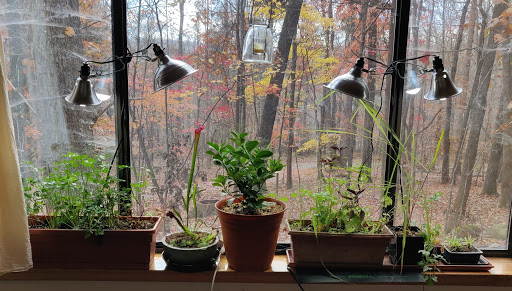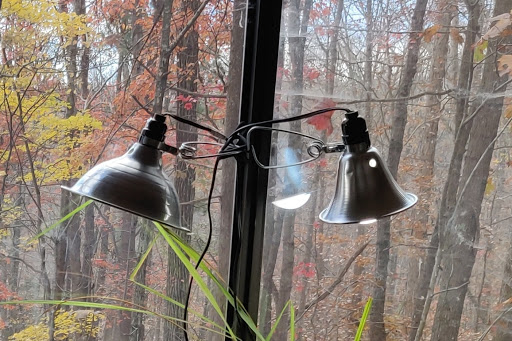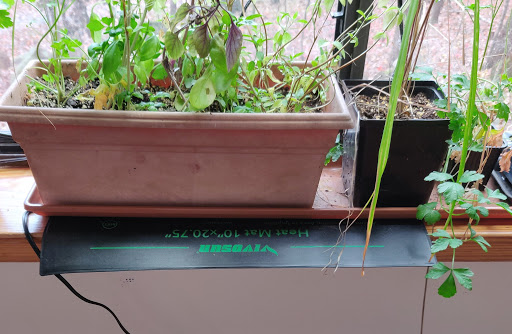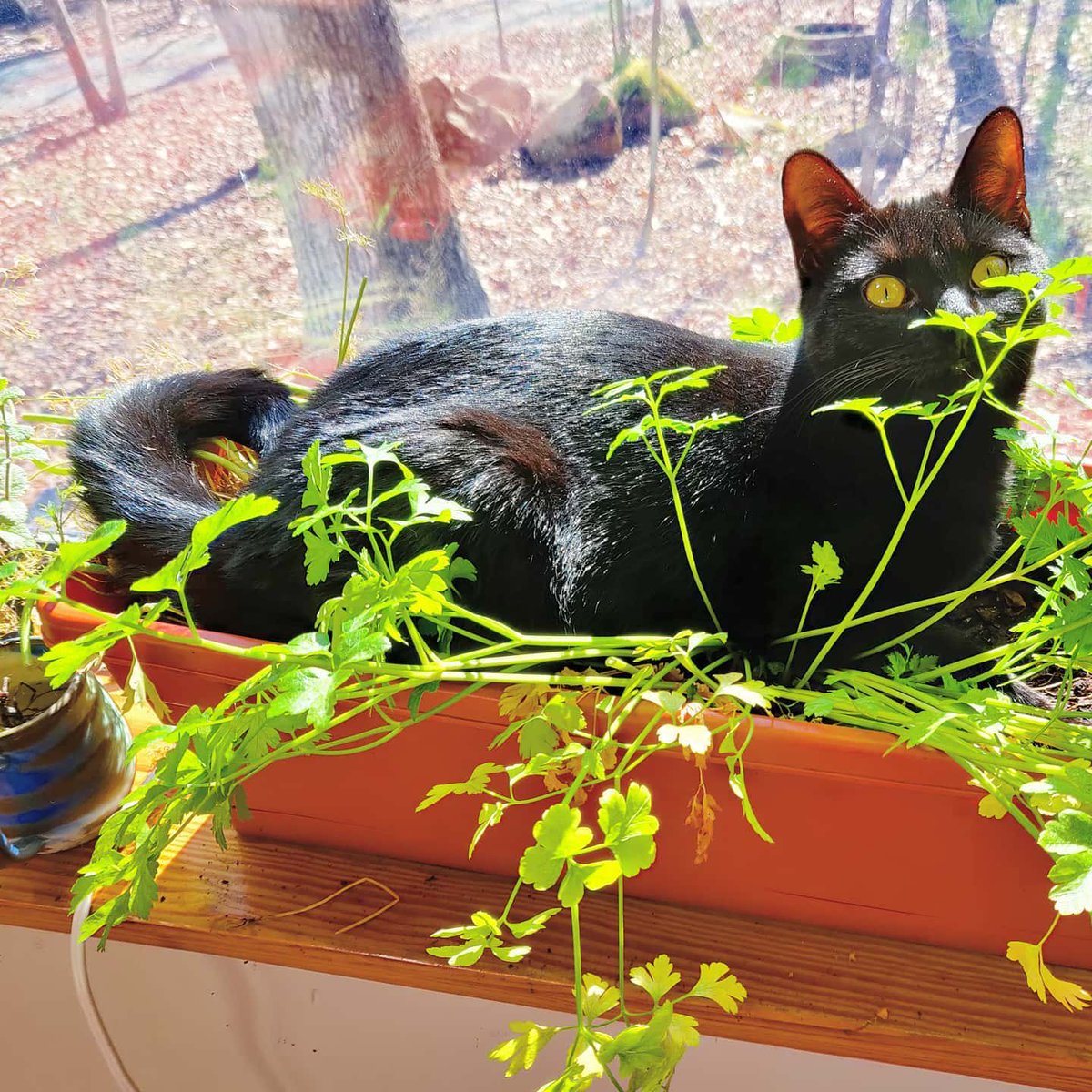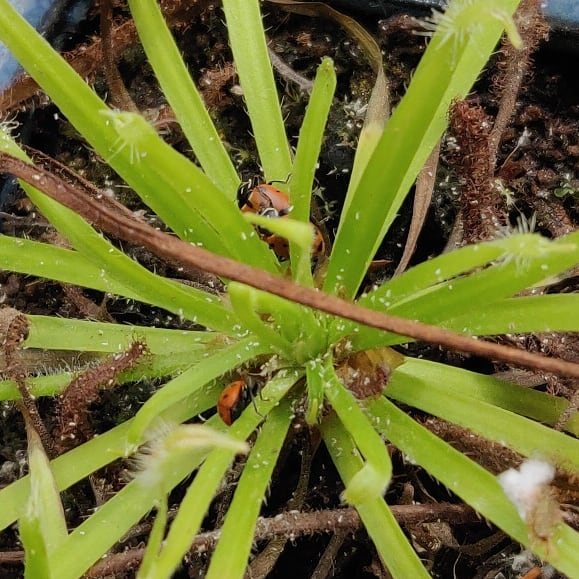So, I'm going to try to do a thread on growing herbs indoors over the winter. Let's see how it goes :-) Keep in mind, this is what I do. It works well, even when I am only halfway staying on top of things.
Not all of these things are necessary. But all of them help a lot. I figure, I try to set up my plants in a situation where thriving is the default, and I have to really fuck things up for them not to do well. It builds in a lot of fault tolerance for me not being on the ball.
The first big requirements are water, light and heat. We'll start with water. Notice that almost all of my pots are pretty big? This is one of the things I see fail people the most. Big pots don't dry out quickly. Tiny ones do. Get the big ones. (That can drain, with saucers.)
There are a lot of adorable little sets of pots for growing herbs in the window. Most of them exist to convince people they have a black thumb. (The rest are some kind of hydroponic.)
Next, light. Now, I live in a passive solar house. This means that during the winter, I get amazing light in my south facing windows. This doesn't mean I get enough light - days are short, and the house still blocks a bunch of it. I still supplement. You should, too.
Really look around your place, and find the best natural light you have. I used to put everything in front of south facing windows on my second floor in Ohio. (Including my tea bush and pomegranate tree.) And then supplement anyway.
(If your light isn't great, supplement more.)
(If your light isn't great, supplement more.)
My lighting system isn't anything special. Shop lamps with full spectrum LED bulbs. I'm basically taking not quite adequate natural light, and adding in a bunch of not adequate by itself artificial light. Together, it's great.
If you need more, we can talk about options.
If you need more, we can talk about options.
(I'm just using 100W replacement full spectrum LEDs from costco. I used to source my bulbs more carefully, but the light here is pretty great on its own - and these do surprisingly well. Light are an arbitrarily deep rabbit hole.)
Oh, and they're also on a timer - I have it set for having them on for about 14 hours a day.
Last of our survival basics - heat. This also is going to vary a lot by where you are and what your windows are like. (Also what you're growing - basil, when young, is likely to swoon at anything less than 50F/10C. Most herbs are hardier. Basil is also delicious and worth it.)
Even aside from that, the microbes that make nutrients available are a lot less active when the soil is cold. NC rarely gets that cold, and my windows are well insulated, so I'm only supplementing my basil pot at the moment. Oh, and the lemongrass.
That black thing under the pots above? That's a propagation mat. They come in a lot of shapes and sizes, and can be found pretty cheap. (They are also the key to starting hot weather vegetables indoors with ease.)
This one is almost narrow enough to fit on my sills.
This one is almost narrow enough to fit on my sills.
This does *not* go on a timer. (Which is pretty obvious, but once you're setting up multiple lights, and probably have an extension cord involved, it's an easy mistake to make.)
So far, I haven't lived anywhere where the propagation mat didn't warm things up enough.
So far, I haven't lived anywhere where the propagation mat didn't warm things up enough.
This includes when I lived on the housebarge... But if you have drafty windows and live somewhere really cold, I'd probably look at getting some twinwall? (Material used for making insulated greenhouses.) We've been looking at it for my PI's office...
Okay! I'm hoping if you've had bad experiences in that past, this will have covered a lot of the common pitfalls. Let's get on to specifics.
First, the plants themselves.
Note, my assortment is a little motley. The parsley is great, the basil not so much.
First, the plants themselves.
Note, my assortment is a little motley. The parsley is great, the basil not so much.
This is because I bought them, and then got bronchitis, and so they sat in their little nursery pots for too long until I got around to planting them. Shit happens! I'm pruning them down and encouraging them to put out new growth, but if not, I'll plant seeds or get more.
(This doesn't mean you have to plant everything the moment you get it. I was sick for a while, and then had a lot of catching up to do. If your environment is decent, plants will generally get by.)
While I recommend getting nice healthy plants from your local nursery to start with, don't over think it. I've started plenty of things from seeds and cuttings - but also grabbed things from in front of the co-op. Aim for healthy, and not full of pesticides.
Next, dirt. Get a nice organic potting soil. These will help keep the moisture level decent, and provide extra nutrition.
Give the plants a bit of room. (Though for me, too much and my cats sunbathe while munching on parsley.)
Give the plants a bit of room. (Though for me, too much and my cats sunbathe while munching on parsley.)
(It's good to check herbs for pet compatibility, especially if your pets are likely to sample them. Google is your friend.)
While we're on the subject of nutrition, your herbs will grow better if they're fertilized regularly. I really like foxfarm fertilizer. If in doubt, dilute more rather than less. I use it at most every couple of weeks with herbs.
Oh! And I haven't mentioned watering. Look, touch the soil. It should be moist, but not soggy. (Decent soil and drainage will prevent the latter.)
If it's dry, water the dirt. Limp plants are often a sign too! (But still, touch the dirt. If it's moist, something else is up.)
If it's dry, water the dirt. Limp plants are often a sign too! (But still, touch the dirt. If it's moist, something else is up.)
So far, we've described a pretty nice set up. Let's talk about some of the things that might go wrong.
Before I get into my specifics, I'm going to mention that google is your friend. I can't cover everything, I haven't even run into a lot of it.
Before I get into my specifics, I'm going to mention that google is your friend. I can't cover everything, I haven't even run into a lot of it.
For search term inspiration, it's sometimes helpful to think of growing plants indoors as being similar to what you run into in a greenhouse. It's a mostly closed systems - pests exist without their natural predators. Pathogens can spread quickly.
(It should surprise no one that if you have a sick plant, you want to quarantine it! In some cases there are remedies, in others you pretty much just want it not to infect your other plants, and it's a goner. I've had less trouble with diseases than I have with pests, though.)
There are a range of different pests and different approaches to pest control. Most folks use pesticides of various kinds. I find maintaining an ecosystem more entertaining, and don't want to eat most pesticides, so I mostly go with beneficial insects.
I've mostly run into spider mites*, mealy bugs, and aphids indoors. I think spider mites are another frequent source of people giving up in herbs, as many are susceptible.
* which you need magnification to see well.
* which you need magnification to see well.
Short term, I'll run the plant under the tap to dislodge the pests?
But my favorite strategies have been lady bugs and carnivorous plants.
But my favorite strategies have been lady bugs and carnivorous plants.
Lady bugs are great generalists! Their nymphs are even better at eating anything that is eating your plants. You can order them online (few gardening stores carry them in the fall) and they'll stay dormant for months in your fridge while you release a few at a time.
Ideally, bring them out when they have something to eat, and they'll mate, lay eggs, and you can get a colony going. But predator prey cycles being what they are, it's good to have backstock to replenish the population.
I'm also a fan of predatory mites, but unless you have a lot of plants, or several friends to share them with, the shipping costs more than the mites. Preying mantises are also a cool idea, but they're prone to cannibalism, and need serious humidity.
I haven't had luck indoors with lacewings, either.
Note - there's a lot I haven't tried. And to me, a bunch of this is being a biologist and liking to futz with systems. Search for beneficial insects! Play!
Note - there's a lot I haven't tried. And to me, a bunch of this is being a biologist and liking to futz with systems. Search for beneficial insects! Play!
But if that's not your jam, go with ladybugs.
Also, with all of these things make sure you check about whether they're native to your region or likely to be invasive.
(A lot of asiatic ladybugs have been released in the US, and are prone to swarming and annoying people.)
Also, with all of these things make sure you check about whether they're native to your region or likely to be invasive.
(A lot of asiatic ladybugs have been released in the US, and are prone to swarming and annoying people.)
On to carnivorous plants!
As some of you know, I've been getting more carnivores recently. This is me having fun. For pest control purposes (like again fruit flies!) I recommend cape sundews and... some kind of easy tropical pitcher plant.
As some of you know, I've been getting more carnivores recently. This is me having fun. For pest control purposes (like again fruit flies!) I recommend cape sundews and... some kind of easy tropical pitcher plant.
Give them good light and "keep their feet wet" - set them on small tray filled with water, so the soil is always moist.
Cape sundews really are the easiest to start with. (This is pretty optional, really? I find them entertaining.)
Cape sundews really are the easiest to start with. (This is pretty optional, really? I find them entertaining.)
In my climate, there are a number of herbs that will overwinter just fine outside, so my rosemary, oregano, and time just stay outside. I only grow the herbs that don't do well with the cold indoors.
Thyme. Really. 

Right now I have parsley, mint, rau ram*, several kinds of basil, and lemon grass. I might add a few? Also, a lime tree and two pots of carnivores.
* My favorite "vietnamese cilantro"
* My favorite "vietnamese cilantro"
Here, my tea bush and pomegranate tree do fine outside, so I'm not hauling them indoors the way I did in Ohio.
Questions?
I messed up the sequence, so am adding this to the end:
None of this is super expensive, especially if you put it together over time. Feel free to improvise - any lamp with some kind of reflector will do to start out with, if it has a full spectrum light.
None of this is super expensive, especially if you put it together over time. Feel free to improvise - any lamp with some kind of reflector will do to start out with, if it has a full spectrum light.

 Read on Twitter
Read on Twitter